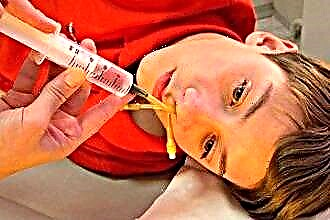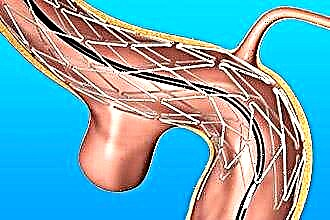Lymph nodes are a biological filter that allows lymph from organs and tissues to pass through. These are rounded small formations located along the lymph flow and near large blood vessels. In the human body, lymph nodes are called regional, there are several dozen groups of them. They are the first to take the blow when the body is infected; in fact, it is an obstacle to the penetration of pathogenic microbes into the body. There are two groups of lymph nodes on the neck: anterior and lateral (lateral) cervical. In adults, lymph nodes with angina rarely enlarge.
Causes of inflammation of the cervical lymph nodes
 Lymph nodes in the neck can be enlarged for a variety of reasons. Main reasons:
Lymph nodes in the neck can be enlarged for a variety of reasons. Main reasons:
- inflammation of the lymph nodes in the neck occurs when the nasopharynx is infected, including with angina, when microbes enter the lymph node; malignant tumors, metastases to the nodes;
- HIV infection; diseases of the thyroid gland;
- immune problems;
- infectious pathologies caused by viruses, bacteria, fungi, helminths, intestinal and purulent bacilli; inflammation in the gums and teeth; sexually transmitted diseases; purulent wounds on the body;
- boils, abscesses;
- the reason for the inflammation of the lymph nodes may be cat scratches on the skin.
Symptoms
Inflammation of the nodes along the course of the process is acute or chronic, by the nature of the inflammation - serous or purulent. In acute tonsillitis, the submandibular lymph nodes are most often affected.
The main clinical manifestations:
- enlargement and compaction of nodes;
- soreness when pressed;
- tingling in the lesions;
- often there may be a constant headache;
- difficulty swallowing, muscle and joint pain, fever, general malaise;
Inflammation of the lymph nodes in the neck according to the clinic may be similar to angina
- the disease becomes serious when not properly treated. The lymph nodes are enlarged, they become harder, the soreness increases without touch;
- at the purulent stage, the nodes are sharply increased, the pain is pronounced twitching, the skin over the lesions acquires a burgundy hue, there is a strong fever. The nodes can coalesce, forming extensive foci of inflammation. Touching the foci causes unbearable pain;
- in the chronic phase, the symptoms may be blurred, the process is sluggish. There are slight swelling on the neck, the body temperature can rise to subfebrile.
Children suffer from lymphadenitis much harder than adults. If timely treatment is not carried out, then the development of the cervical spine may be impaired in newborns.
With angina, the lymph nodes are usually inflamed on both sides. In turn, inflammation of the nodes can lead to even greater enlargement, swelling and soreness of the tonsils, which is characteristic of acute tonsillitis.
Diagnostics
Lymph nodes can be enlarged with a hundred diseases. It is imperative to consult a specialist if such a symptom is found. Even if lymphadenitis occurs against the background of angina, this does not exclude other causes of the disease, so the doctor pays attention to the accompanying symptoms.
Only a specialist can figure out why there was an increase in lymph nodes
The doctor will conduct an examination, palpation, and prescribe an ultrasound examination of the lymph nodes. You may need advice from other specialists: a surgeon, dentist, oncologist, infectious disease specialist. Additional research: analysis for HIV infection, computed tomography. If the inflammation lasts six months or more, then a biopsy is performed with further morphological examination of the tissues to exclude a malignant formation.
Treatment
Traditional therapy
For the period of treatment, you need to be away from the use of creams, lotions, tonics, perfumes
With inflammation of the lymph nodes in the neck, treatment is prescribed to eliminate the causes. With angina, antibacterial and anti-inflammatory therapy is carried out, general strengthening drugs, vitamins, drugs that alleviate symptoms are prescribed. The selection of the main remedies is carried out depending on the pathogen. If tonsillitis and lymphadenitis are caused by bacteria, then broad-spectrum antibiotics are prescribed. For fungal infections, antifungal drugs are used. With viral sore throat, antiviral agents are prescribed.
In most cases, treatment is carried out on an outpatient basis. Hospitalization is necessary when the process is running, when excision of foci of inflammation or opening of an abscess is carried out with further drainage of the node for the discharge of pus. After the symptoms subside, physiotherapeutic treatment is carried out: UHF, electrophoresis, galvanotherapy.
It is impossible to put warming compresses on the foci of inflammation.
Treatment with non-traditional methods
- Dilute 10 drops of Echinacea purpurea in 100 ml of water. Divide the solution into three doses. The plant has antiseptic and anti-inflammatory effects.
- With camphor oil, do gentle, light rubbing of lesions.
- Make compresses with ichthyol ointment.
- Gargle with saline.
- Drink herbal decoctions with anti-inflammatory effect.
- Apply green jadeite to the affected area for 5 minutes. Carry out the procedure 2-3 times a day.
- One teaspoon of Canadian yellow root is diluted in one glass of water. Take a glass every day, while consuming fermented milk products to avoid indigestion.
- Take one tablespoon of aloe juice daily.
With lymphadenitis, it is impossible to do an iodine mesh on the lesions, use a heating pad, warming compresses. These procedures contribute to the rapid spread of inflammation along the bloodstream
Complications and prevention
Negative consequences
 If adequate treatment of lymphadenitis is not carried out in a timely manner, then this can lead to the formation of an abscess - adenophlegmon. Adenophlegmon is characterized by a severe course: high temperature, severe intoxication, pain in the head, heart, muscles.
If adequate treatment of lymphadenitis is not carried out in a timely manner, then this can lead to the formation of an abscess - adenophlegmon. Adenophlegmon is characterized by a severe course: high temperature, severe intoxication, pain in the head, heart, muscles.
The skin over the affected area on the neck turns red, hyperemia extends beyond the lymph node, softening foci appear, which indicates an accumulation of pus. Inflammation of the nodes on the neck of a baby does not allow the child to hold his head correctly. This can lead to impaired development of the spinal column in the cervical spine.
Prophylaxis
Prevention of cervical lymphadenitis consists in observing general preventive measures:
- maintaining and strengthening the immune system;
- timely treatment of infectious diseases;
- hardening procedures;
- rational nutritious food;
- avoidance of soft tissue injuries, infection of the wound surface;
- observance of personal hygiene;
- exclusion of contact with infected people;
- during a sore throat illness, you need to adhere to bed, food and drinking regime.
In order for the treatment of cervical lymphadenitis with angina to be effective, you need to know why the inflammation occurred. If you experience symptoms of the disease, do not forget to consult a specialist.



